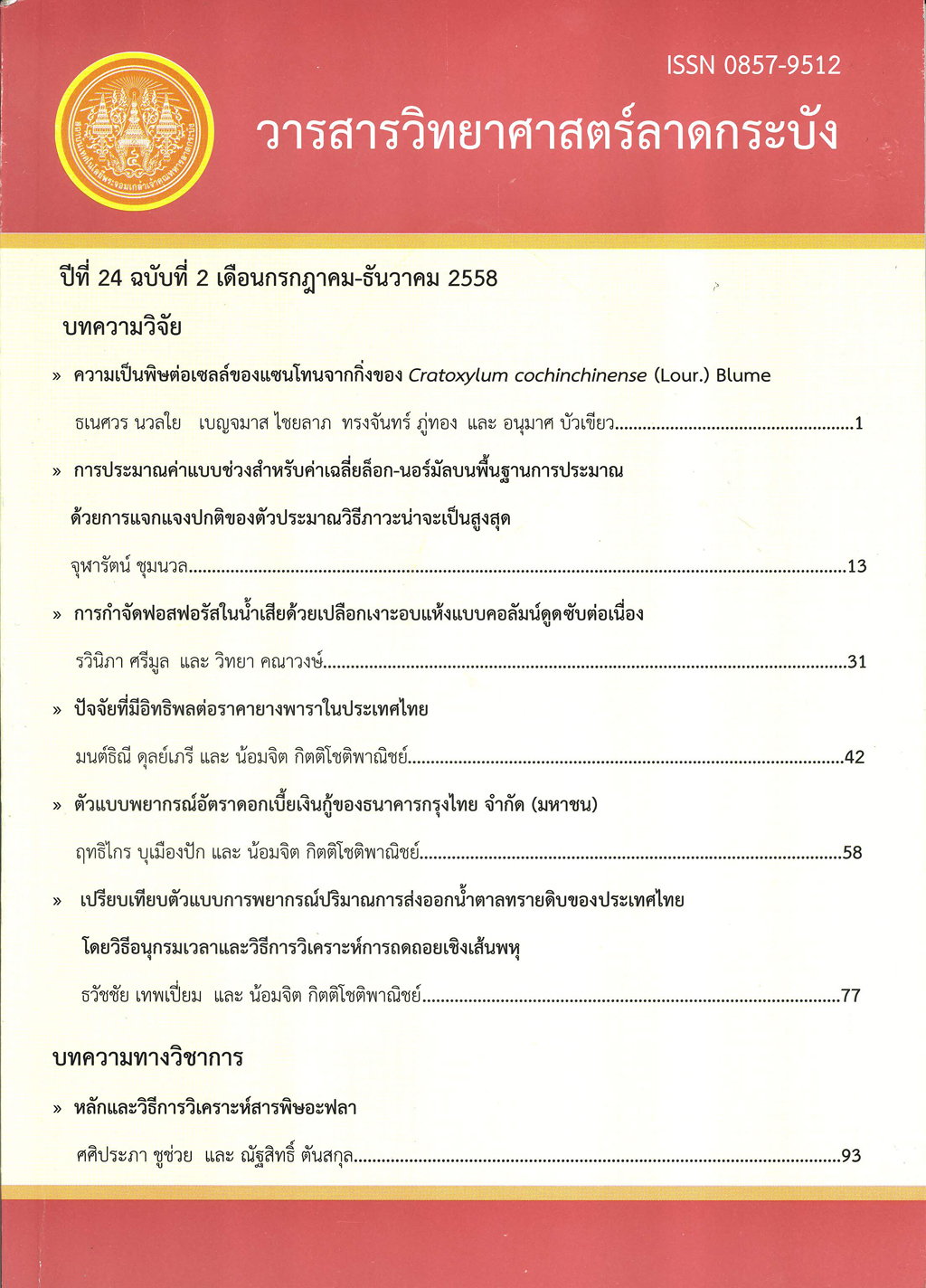ความเป็นพิษต่อเซลล์ของแซนโทนจากกิ่งของ Cratoxylum cochinchinense (Lour.) Blume
Main Article Content
Abstract
บทคัดย่อ
จากการสกัดและแยกสารส่วนสกัดเฮกเซนส่วนกิ่งของติ้วเกลี้ยง (Cratoxylum cochinchinense) สามารถแยกสารกลุ่มแซนโทนได้ทั้งหมด 6 ชนิด คือ 1,3,7-trihydroxy-2,4-di-isopropylxanthone (1), Cochinchinone A (2), 7-geranyl-1,3,7-trihydroxy-4-(3,3-dimethylallyl)-xanthone (3), Dulcisxanthone B (4), ß-mangostin (5) และ Dulcisxanthone F (6) สารบริสุทธิ์ทั้งหมดพิสูจน์ทราบเอกลักษณ์ของสารโดยเทคนิคทางสเปกโทรสโกปี (1H, 13C, COSY, HSQC และ HMBC) และเปรียบเทียบข้อมูลจากรายงานวิจัยก่อนหน้า จากผลการศึกษาความสัมพันธ์ระหว่างโครงสร้างและความเป็นพิษต่อเซลล์มะเร็งพบว่า ความมีขั้วส่งผลต่อความเป็นพิษต่อเซลล์มะเร็ง และสาร 1,3,7-trihydroxy-2,4-di-isopropylxanthone (1) แสดงความเป็นพิษต่อเซลล์มะเร็งทั้ง 5 ชนิดคือ มะเร็งเต้านม (BT-474), มะเร็งปอด (ChaGo-K-1), มะเร็งตับ (HepG2), มะเร็งกระเพาะอาหาร (KATO-III) และ มะเร็งลำไส้ใหญ่ (SW-620) โดยสามารถยับยั้งการเพิ่มจำนวนเซลล์ร้อยละ 50 ของการเจริญเติบโต (IC50) มากที่สุดที่ระดับ 1.05, 0.46, 0.46, 0.63 และ 3.11 mg/mL ตามลำดับ
คำสำคัญ : ติ้วเกลี้ยง, ความเป็นพิษต่อเซลล์
Abstract
Six xanthones; 1,3,7-trihydroxy-2,4-di-isopropylxanthone (1), Cochinchinone A (2), 7-geranyl-1,3,7-trihydroxy-4-(3,3-dimethylallyl)-xanthone (3), Dulcisxanthone B (4), ß-mangostin (5) and Dulcisxanthone F (6) were isolated from hexanes extract of twigs of Cratoxylum cochinchinense. The structure of pure compounds were elucidated by basic NMR spectroscopy (1H, 13C, COSY, HSQC and HMBC) and compared with previous literature reviews. The structure activity relationship of these compounds displayed that the polarity of compounds played important role in cytotoxicity of five human cancer cell lines. Furthermore, 1,3,7-trihydroxy-2,4-di-isopropylxanthone (1) showed the most of the half maximal inhibitory concentration (IC50) of five human cancer cell lines; breast (BT-474), lung (ChaGo-K-1), liver (HepG2), gastric (KATO-III) and colon (SW-620) as 1.05, 0.46, 0.46, 0.63 and 3.11 mg/mL, respectively.
Keywords : Cratoxylum cochinchinense, Cytotoxicity

